What the ... ?
Drew Jeffers, Horticulture and Natural Resources Agent of Spartanburg County, South Carolina, forwarded a picture of a brownish worm to me. The picture was taken by Todd Kury of Upstate Arborists based in Spartanburg, South Carolina. Drew and Todd wondered what the worm might be. Looks to me that the leaf may belong to an elm tree, but I’m not sure which species.
I have a pretty good idea what this is. What about you?
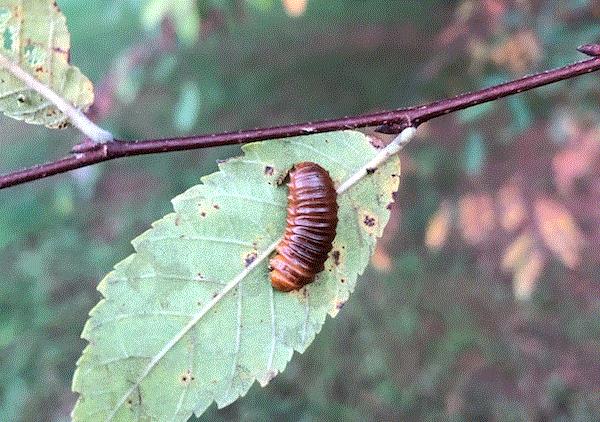
Photo credit: Todd Kury, Upstate Arborists.
Crapemyrtle Bark Scale Egg Production is Near
I also received a few pictures from Predeesh Chandran, the insect diagnostician at Clemson University, of crapemyrtle bark scales (CMBS) infesting American beautyberry. I'd heard of CMBS infesting American beautyberry before, but this is really the first time I’ve seen samples of the infestation. Now, I just need to get samples or pictures of CMBS on spirea and St. John's wort, which was reported in North Carolina and Virginia, respectively, then my life would be complete. What can I say? I’m a simple entomologist.
I saw in the pictures that the CMBS population in South Carolina has reached the adult stage. You’ll see two kinds of CMBS in the picture below. The ones that are completely covered with white fuzz are mature adults that are about to lay eggs. Y’all can also see some reddish individuals that have no white fuzz; these are nymphs or young adults before they start producing the white fuzz. The presence of adults tells me that the fall emergence of crawlers is about to start in a few weeks.
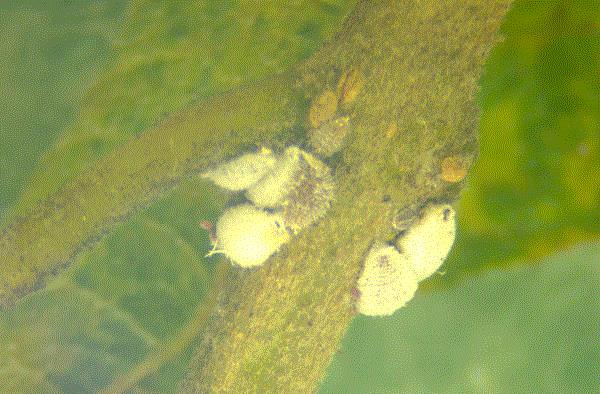
Photo credit: Predeesh Chandra, Clemson University.
Based on observations from Texas, CMBS has at least two generations. Egg hatch and crawler emergence in Texas peak in late April to mid-May, and again in late September to mid-October. Emergence timing elsewhere in the country is similar to or slightly behind that. Y’all can find the most accurate timing of crawler emergence in your location by monitoring for them using a sticky tape trap.
This is also a good opportunity for me to do some shameless self-promotion. Check out my article in the August 2022 issue of GrowerTalks, “Managing Crapemyrtle Bark Scale in Nurseries,” if you want to learn more about what CMBS can do in nurseries or to find out how to control them, including how to monitor for crawler emergence and what products to use.
I’ve seen continuous spread of CMBS into more counties in South Carolina since this invasive insect was first found in the state capital, Columbia, in 2019. What’s really concerning is their invasion into horticultural trade, which can help them spread faster and further.
I encourage all growers and buyers of crapemyrtles to be extra vigilant about this pest, which has made crapemyrtles from a once low-maintenance plant into a rather problematic one. I hope my article can be of use in your effort to control them.

Crapemyrtle Bark Scale Life History is Revealed
In July, a team led by Mengmeng Gu at Texas A&M University published a paper in the scientific journal Scientific Reports. The paper provides the most comprehensive view of the life history of CMBS to date. The paper reports on the developmental time, survival rate and fecundity of this invasive insect species.
What’s really awesome about the new paper is a well-done color chart of the life cycle of CMBS, from eggs to egg-laying adults. I’ve placed a copy of the life cycle chart here, but it doesn’t do the chart justice because of the low resolution required for this newsletter publishing platform. To read the paper and get a copy of the chart in original resolution, click HERE.
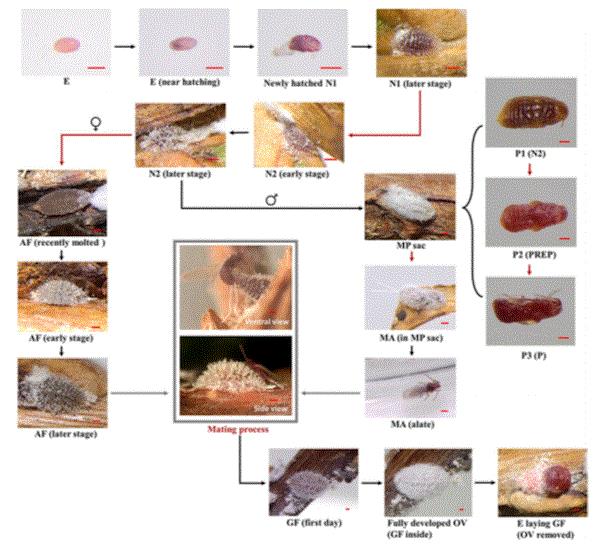
Source: Rie, et al. 2022.
Very similar to other scale insect species, female CMBS develops through two nymphal instars before becoming adults. Males, on the other hand, go through one extra nymphal instar when they encase themselves in waxy tubes like pupae. There aren't a lot of wax on the outside of the adult females before they mate, but wax filaments form a protective layer on the outside of the reproducing females.
On average, it takes a female about 90 days and a male about 110 days to complete development from egg to adult. The duration of development is shortened by 6% if the host plants are grown in nutrient-enriched media (0.43 g Murashige-Skoog salt per 1 L of media). Adult males live for about three days and adult females live for about a month. During this time, a female can produce 49 eggs over nine days. Rearing the scale insects on crapemyrtle liners grown in nutrified media didn't seem to increase the number of eggs produced each day.

The 2023 IMF Guide is Now Available
The 2023 GrowerTalks Insecticide, Miticide & Fungicide Guide, sponsored by BASF, is now available. I think the front cover is especially attractive this year. A thrips-damaged flower is a thing of beauty, don’t you think?
What’s really exciting this year is that the IMG Guide is now available in both English and Spanish! Kudos to both GrowerTalks and BASF for making this useful annual publication accessible to many of our Spanish-speaking team members.
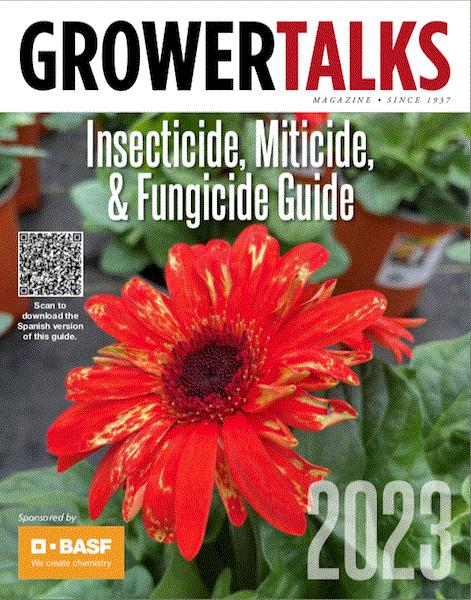
The new IMF Guide contains the most up-to-date lists of fungicides organized by FRAC, and insecticides and miticides organized by target pests. The insecticide and miticide list was compiled by Raymond Cloyd of Kansas State University. And don’t miss this—a list of herbicides commonly used in nurseries compiled by Chris Marble of the University of Florida is available at the end of the guidebook.
Chris also contributed an article on the importance of preemergent herbicide rotation. Suzanne Wainwright contributed a couple of articles on how to use beneficial nematodes for pest management. The IMF Guide this year also features rotation programs for major diseases and pests.

Answer to "What the ... ?"
The worm is a larva of the larger elm leaf beetle, Monocesta coryli. I know there's an elm leaf beetle (Xanthogaleruca luteola), but I wonder if there's a lesser or smaller elm leaf beetle? Common name of insects can be somewhat perplexing or downright confusing at times.
Adult larger elm leaf beetle is pretty big—about 4/10 to 6/10 in.—with an orange body and head, and an orange band across the metallic blue wings (or four metallic blue dots on orange wings; potato, potatoe). Larvae are up to ¾ in. long and dark orange or rusty brown in color. You can’t miss them.
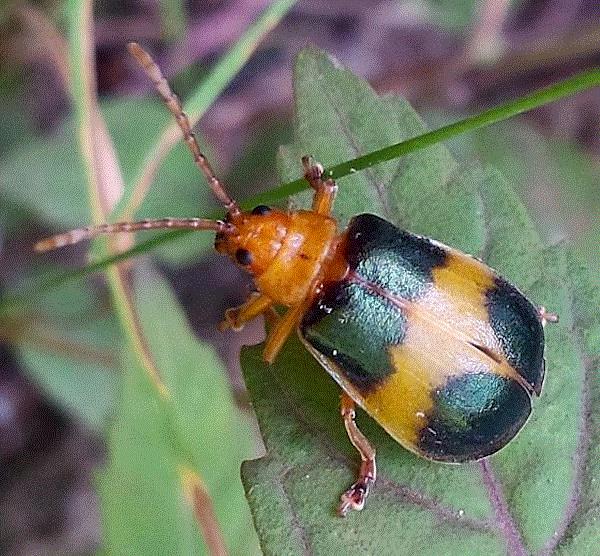
Photo credit: M. Huston; Bugguide.org.
Both adults and larvae skeletonize elm leaves. It’s likely that all elm species and cultivars are susceptible. The beetle is also known to feed on hazel, hawthorn, birch and pecan. It's been associated with plum, dogwood and other species, but it’s not known if it'll cause severe damage on these alternative hosts.
The damaged leaves dry up and turn brown, but stay on the branches, making the terminal and leaves looked “burned” or “scorched.” I haven’t seen or heard any outbreaks of the larger elm leaf beetle in the South in the past 20 years. It seems that they can cause localized outbreaks for a year or two, then disappear for many years.
The fact that the beetles are only a problem locally and for a short period of time, and that natural enemies (such as parasitic flies) can usually keep up, I think that the best management approach may be to wait them out. Yes, the damaged trees will look awful for the season, but the damage won’t kill them. Once the beetles are gone and the trees flush in the spring, it’ll be like nothing happened.
As far as I know, no one has conducted experiments to evaluate the efficacy of different insecticides. I could only provide Todd with a recommendation based on my experience with or data from other leaf beetle species. I think a foliar spray with spinosad (Conserve), chlorantraniliprole (Acelepryn) and cyantraniliprole (Mainspring) targeting the larvae is likely the most effective treatment. Acephate, carbaryl and pyrethroids are likely effective, but I’m hesitant to recommend these products because of their high impact on the natural enemies of the beetles. I’m not sure if soil drench, injection or basal trunk application of systemic insecticides is effective in preventing damage, but my experience with the efficacy of these products against leaf beetles leads me to say no.
Michael Thomas (with the Florida Division of Plant Industry at the time of publication, but passed away in 2019) published a great factsheet on the larger elm leaf beetle. Click HERE to access the factsheet.
I talked about elm leaf beetle (yes, the not-so-large species) exactly a year ago in this newsletter. Read that newsletter to revisit this species or check out a great factsheet by Whitney Cranshaw of Colorado State University. The elm leaf beetle is widely distributed in the United States and eastern Canada, so there's a chance that you may see both species on the same tree. The elm leaf beetle (2/10 to 3/10 in.) is much smaller than the larger elm leaf beetle.




See y'all later!

JC Chong
Professor of Entomology at Clemson University
This e-mail received by 27,389 subscribers like you!
If you're interested in advertising on PestTalks contact Kim Brown ASAP!